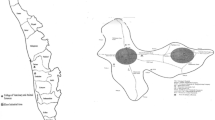Abstract
The present study was carried out to determine the levels and changes of vitamins A, C, and E, fluoride, and calcium in 30 Morkaraman sheep with fluorosis, comparing them to unexposed healthy controls. The sheep exposed to fluoride showed significant differences in urinary fluoride and the blood levels of beta-carotene and vitamins A and C (p < 0.001) as proof of the impact that fluorosis have in the overall health of the animals.
Similar content being viewed by others
References
Mert N, Bildik A, Ertekin A, Dede S (1999) Biochemistry. University of Yuzuncu Yil Faculty of Veterinary Pres, Van, Turkey, pp 195–196
Heifetz SB, Horowitz HS (1984) The amounts of fluoride in current fluoride therapies, safety considerations for children. J Dent Chil 51:257–269
Shupe JL (1980) Clinicopathologic features of fluoride toxicosis in cattle. J Anim Sci 51:746–758
Ergun H, Russel HA, Baysu N, Dundar Y (1987) Studies on the fluoride contents in water and soil urine, bone, and teeth of sheep and urine of human from eastern and western parts of Turkey. Dtsch Tierörztl Wschr 94:416–420
Susheela AK (1999) Fluorosis management programme in India. Curr Sci 77:1250–1256
WHO (1984) Environmental health criteria for fluorosis and fluoride. World Health Organization, Geneva, pp 1–136
Oruc N (1977) Fluorid content of some spring waters and fluorosis in the eastern Anatolia; seminar on problems of high fluoride waters. Cento Scientific programme Ataturk University, Erzurum, Turkey
Sendil C, Baysu N (1973) First communication on fluorosis encontered in humans and animals living in the villages of Dogubeyazit, Agri and the villages of Muradiye, Van in Turkey. A U Faculty of Veterinary Jour 20:474–485
Uslu B (1984) The growth of skeleton in fluorosis. T Kl Med Sci Res 2:37–40
Krishnamachari KAVR (1976) Further observations on the syndrome of endemic genu valgum of South India. Indian J Med Res 64:284–292
Lakshmaiah N, Srikantia SG (1977) Fluoride retention in humans on sorghum and rice based diets. Indian J Med Res 65:543–548
Das AA (1996) Fluorosis. In: Bamji, MS, Rao, NP, Reddy, V (eds) In text book of human nutrition. Oxford, New Delhi, pp 424–440
Krishnamachari KAVR (1986) Skeletal fluorosis in humans: A review of recent progress in the understanding of the disease. Prog Food Nutr Sci 10:279–314
Goldhaber P (1967) The inhibition of bone resorption in tissue culture by nontoxic concentrations of sodium fluoride. Israel J Med Sci 3:617–627
Harrison JE, Hitchman AJ, Hitchman A, Haltrope ME (1990) The effects of fluoride on ectopic bone formation. J Bone Miner Res 5:81–85
Carlson JR, Suttie JW (1966) Pentose phosphate pathway enzymes and glucose oxidation in fluoride-fed rats. Am J Physiol 210:79–83
Park S, Ajtai K, Burghardt P (1999) Inhibition of myosin ATPase by metal fluoride complexes. Biochem Biophys Acta 1430:127–140
Vani ML, Reddy KP (2000) Effects of fluoride accumulation on some enzymes of brain and gastrocnemius muscle of mice. Fluoride 33:17–26
Reddy GB, Khandare AL, Reddy PL, Rao GS, Balakrishna N, Srivalli I (2003) Antioxidant defense system and lipid peroxidation in patients with skeletal fluorosis and in fluoride-intoxicated rabbits. Toxicol Sci 72:363–368
Singer L, Armstrong WD, Vogel JJ (1969) Determination of fluoride content of urine by electrode potential measurements. J Lab Clin Med 74:354–358
Suzuki I, Katoh N (1990) A simple and cheap methods for measuring serum vit. A in cattle using spectrophotometer. Jpn J Vet Sci 52:1281–1283
Omaye ST, Turnbul JD, Sauberlich HE (1979) Ascorbic acid analysis II. Determination after derivatisation with 2.2.dinitrophenylhidrazine selected methods for determination of ascorbic acid in animal cells. Tissues Fluids Meth Enzymol 62:7–8
Martinek RG (1964) Method for determination of vitamin E history (total tocoferols) in serum. Clin Chem 10:1078–1086
Munoz JR (1968) Atomic absorption spectroscopy and analysis by atomic absorbtion flame photometry. Elsevier, New York
Hayran M, Ozdemir O (1996) Computer statistics and medicine. Medikomat, Press Unity of Physicians, Ankara, Turkey, pp 85–86
Yur F, Belge F, Mert N, Yoruk I (2003) Changes in erythrocyte parameters of fluorotic sheep. Fluoride 36:152–156
Susheela K (1999) Fluorosis management programme in India. Curr Sci 77:1250–1256
Chinoy NJ, Memon MR (2001) Beneficial effects of some vitamins and calcium on fluoride and aluminium toxicity on gastrocnemius muscle and liver of male mice. Fluoride 34:21–33
Chinoy NJ, Patel JN (2001) Effects of sodium fluoride and aluminium chloride on ovary and uterus of mice and their reversal by some antidotes. Fluoride 34:9–20
Dogan I (2002) Investigation of antioxidant compounds of fluorotic sheep. MSci. Thesis. Yuzuncu Yil University, Health Science Institute, Department of Biochemistry, Van, Turkey
Li J, Ca S (1994) Recent studies on endemic fluorosis in China. Fluoride 27:125–128
Rzenski R, Chhubek D, Machoy Z (1998) Interactions between fluoride and biological free-radical reactions. Fluoride 31:43–45
Shivarajashankara YM, Shivashankara AR, Hcnumanth RS, Gopalakrishna BP (2001) Oxidative stress in children with endemic skeletal fluorosis, research report. Fluoride 34:103–107
Shivarajashankara YM, Shivashankara AR, Bhat PG, Rao SH (2001) Effect of fluoride intoxication on lipid peroxidation and antioxidant systems in rats. Fluoride 34:108–113
Kalaycioglu L, Serpek B, Nizamlioglu M, Baspinar N, Tiftik AM (2000) Biochemistry, 2th edn. Nobel, Ankara, Turkey, pp 277–282
Chinoy NJ, Sharma A (1998) Amelioration of fluoride toxicity by vitamins E and D in reproductive functions of male mice. Fluoride 31:203–216
Krishnamachari KAVR, Lakshmaiah K (1975) Lack of effect of massive dose of vitamin C on fluorides excretion in fluorosis during a short clinical trial. Am J Clin Nutr 28:1234–1236
Shangguan C, Wang W, Sun J (1995) A study on the value of vitamin C in treating sketal fluorosis. Zhoughua Nei Ke Za Zhi 34:761–763
Acknowledgment
The financial support of Yuzuncu Yil University is gratefully acknowledged.
Author information
Authors and Affiliations
Corresponding author
Rights and permissions
About this article
Cite this article
Yasar, S., Yur, F. Antioxidant Vitamin and Mineral Levels in Sheep with Fluorosis. Biol Trace Elem Res 123, 139–143 (2008). https://doi.org/10.1007/s12011-008-8089-8
Received:
Revised:
Accepted:
Published:
Issue Date:
DOI: https://doi.org/10.1007/s12011-008-8089-8




